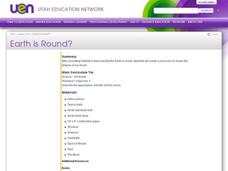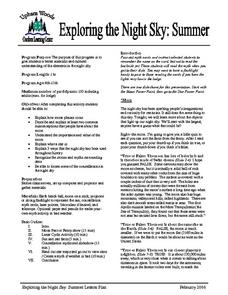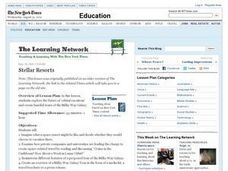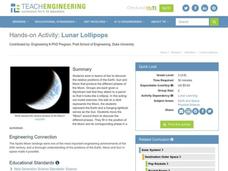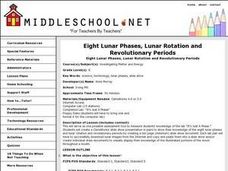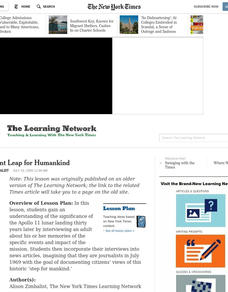Curated OER
Earth is Round?
Third graders discuss how Aristotle concluded that the Earth was round. As a class, they review theories about the Earth's shape and describe how life on Earth would be different if it were flat. Individually, they make a moon book in...
Curated OER
Exploring the Night Sky: Summer
Students explain how moon phases occur. They describe and explain at least two common misconceptions that people have about the moon. Students explain what a star is. They explain 3 ways that the night sky has been used throughout history.
Curated OER
Phases of the Moon
Students answer the question, "How are the motions of the Earth, the moon, and the sun, related to the moon's phases?" They observe the moon to create a moon journal and a phases of the moon diagram.
Curated OER
Discover Magazine: Size and Scale
Students research measurements of the moon and Earth as well as the distance between the two in order to create scale models of the Earth-moon system. With a marble to be used as the moon, they must determine how large to make Earth...
Curated OER
Voyage: A Journey through our Solar System
Learners build the Voyage scale model of the Solar System on a playground and "travel" to each planet. They recognize that the Sun and planets are tiny worlds in a vast space, giving them a new perspective on the Solar System, and...
Curated OER
Sun and Moon Folktale
Learners become familiar with characteristics of folktales by reading or listening to African folktale that explains why sun and moon live in the sky. Students then create their own folktales about the sun and moon or another aspect of...
Curated OER
Moon
Students discover scientific facts about the Moon and how
some American Indian Tribes used the moon to measure time.
They accomplish this by listening to stories and poetry, writing
stories, communicating with an astronaut,...
Curated OER
The Sun and Moon
Students understand basic concepts about Earth, the Sun and the Moon,
such as relative movement and the phases of the moon. Through discussion, looking at pictures, listening to Native American stories, observing, and building models,...
Curated OER
Dark Side of the Moon
Students discover the position of the Earth, Moon, and Sun during each of the phases of the Moon. They then draw a diagram to show the position of the Moon, Earth, and Sun in each of the phases of the moon.
Curated OER
28 Days - The Lunar Cycle time line
Third graders create a labeled lunar diagram time line illustrating the lunar cycle using Internet resources. An assigned date/month is given to each student, and an online Moon Phase calculator assists them with their drawings.
Curated OER
We Are Lunar tics!
Second graders, working in cooperative groups, will create a multimedia presentation about the Earth's moon. Their research must be presented through three or more methods. (i.e. charts; graphs; oral reports; multi-media; dramatic role...
Curated OER
Stellar Resorts
Students explore the future of "orbital vacations" and create fanciful tours of the Milky Way Galaxy. Students respond to the following prompt in their journals "Entrepreneurs are currently designing concepts for accommodating tourists...
Curated OER
Mission: Moon!
Students, in groups, participate in a simulated lunar mission. They roll a Lunar Cube to determine the type of information they will collect during their mission and strategize as to which "lunar location" they need to visit and,...
Alabama Learning Exchange
The Moon's Craters
Fifth graders investigate the formation and size of impact craters. In small groups, they conduct an experiment that involves dropping marbles into flour and measuring the impact from various heights and discussing their hypothesis and...
Curated OER
Tides & Lunar Cycles
Students demonstrate how the moon affects the tides, a neap tide, and spring tides by using their bodies as models. After students observe the model they created, they draw and label the diagram on a provided worksheet. They then log...
Curated OER
Exploring the Moon
First graders complete an experiment illustrating why the moon appears to change over time using a flashlight and ball. Students discuss the shape of the moon and identify it as a sphere. Students write a short informational piece after...
Curated OER
Lunar Lollipops
Students work with a partner, Styrofoam ball and light source to simulate the positions of the Earth, Moon and Sun at various stages during the phases of the Moon. They describe why the Moon is visible from Earth and complete a worksheet.
Curated OER
Wobbling in Circles
Sixth graders role play the parts of the sun, the moon and the Earth as they simulate the concepts of revolution and rotation. They act out the parts in small groups and discuss the concepts as a class.
Curated OER
Spinning into Space
Students, through hands-on activities, teacher demonstrations, pictures, and informational books, complete a unit on the Earth and its place in the Universe. They make mobiles of the Milky Way and watch demonstrations of lunar and solar...
Curated OER
Eight Lunar Phases, Lunar Rotation and Revolutionary Periods
Eighth graders create a slide show to show their knowledge of the eight lunar phases and lunar rotation and revolutionary periods.
Curated OER
Phase to Phase with the Moon
Fourth graders study the Moon phases. The instructional activity includes hands-on activities as well as web-based activities. They use models of the Moon and a lamp to study each of the phases of the Moon, and test their knowlege of the...
Curated OER
Earth, Sun, and Moon
Students participate in a demonstration and complete an online activity that illustrates the earth orbits the sun once a year, and that the moon takes approximately 28 days to orbit the earth.
Curated OER
Birthday Moons
Young scholars examine the lunar phases by locating and graphing the Moon phase of their own birthdays. They listen to and discuss lunar myths and create their own Birthday Moon Stories.
Curated OER
"One Giant Leap for Mankind"
Students explore the significance of the Apollo 11 lunar landing by interviewing an adult for memories of the mission. They incorporate their interviews into news articles as 'journalists' in July 1969 to document this historic 'step for...


